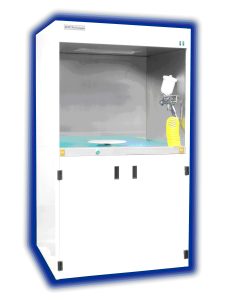How to Setup a Conformal Coating Spray Operation
Posted by Sean Horn
Friday, June 30, 2017 8:00
@ 8:00 AM
As the name suggests, spray coating is a method of application where the conformal coating is sprayed directly onto the printed circuit board (PCB). It is typically applied manually in a spray booth or by aerosol, although it can be automated/robotic, for selective coating assignments.
PCBs benefit from the protection provided by spraying liquid conformal coatings – acrylic, epoxy, silicone and urethane – onto their substrate surfaces. This level of protection assures ongoing PCB-functionality. Essential to any spray coating project is determining:
- the project’s volume,
- production time needed to complete each step of the process,
- the number of workers required to complete the project, and
- type of equipment is needed.
Versatile spray applications are very cost-effective. They can be completed manually benchtop, an efficient method for smaller-scale rework and repair jobs. Spray operations can also be scaled-up in a dedicated spray booth for medium-level production. So long as the PCB is clean and the selected coating material has no adhesion issues, a skilled and appropriately trained operator can process the assignment with a quality-of-surface-finish superior to all other liquid application methods. Aerosol spray procedures can be automated for greater coating accuracy and faster production time. Robotics have become a key component of high volume spray application jobs.
Spray Coating Processes
Manual Spray Coating Processes
When done manually or with aerosols, film material is typically diluted with solvents to achieve a predetermined viscosity and sprayed from all four quadrants at a 45 degree angle.
Manual processes are best used for reworking a PCB-location absent sufficient coating to meet project specifications. They are less reliable for original coat; human error can cause inaccurate application of coating thickness, both causes for rework.
Versatile non-aerosol processes can be manually applied with a spray gun. Automated non-aerosol spray equipment drives the coating through a needle to the substrate surface. Unlike aerosol methods, coating material is not atomized by compression; rather a fan in the nozzle sprays the coating onto the substrate. Non-aerosol sprays can deposit a much thicker coating film on the designated surface, only suitable for assignments where thicker coating is specified.
Special equipment is required for applying conformal coatings by aerosol methods, to appropriately atomize film material into a fine mist. Using air pressure to force liquid coating through a small-vented cavity, spray misting promotes an exceptionally even, but very fine, film across the substrate surface. The initial coating layer will be very thin, necessitating additional spray applications — multiple passes build the coating up to acceptable thickness. However, good masking is necessary to contain the process because aerosol spraying tends to distribute coating material everywhere.
Robotic/Automated Spray Coating Processes
Robotic coating is useful for larger-scale batch assignments, being far more cost-effective for operations at this scale. Infinitely repeatable, selective robotics lower production time as well, offering better control of coating thickness, for both board-to-board and batch-to-batch. Masking may still be necessary, despite the ability to program robotic functions like plating/un-plating. PCB regions like connectors or mounting holes must be coating-free; their position/size can make them difficult to program around. Misaligned PCB components can damage spray-heads as they traverse the board according to automated spray-patterns; unmasked components can also be functionally impaired. Spray heads are among the most essential of the robot’s mechanisms; repair is time-consuming and costly. Programming costs represent a significant portion of the project’s budget. Often, joining older procedures – masking – with new – robotic coating – is the best option. Yet, a major benefit of robotics is that masking procedures can be reduced in many cases. Careful strategic management is a fundamental aspect of robotics’ decisions. While built to improve production efficiency, robotic spray machines are no panacea; incorrect application leads to downtime, slowing production.
Conformal Coating Spray Facility Requirements
 A spray coating facility for high-quality conformally coating requires a well-ventilated workspace. Additional recommended features include:
A spray coating facility for high-quality conformally coating requires a well-ventilated workspace. Additional recommended features include:
- Spray booth: Allows easy, even coating application with a high-quality spray gun, efficiently extracting fumes in the process. Repeat application generates optimal coating finish and protection. Positioning UV light over the PCB during coating improves operator vision and control, minimizing the development of shadowing effects; a manual or automatic turntable further limits shadowing.
- Curing cabinet: For storage of drying PCBs after application, the curing cabinet extracts air surrounding them, drying assemblies while removing potentially hazardous fumes. Each PCB’s stationary position within the cabinet ensures the coating does not flow, which would cause deviation in the film’s thickness, challenging its capacity to provide specified conformal protection. Airborne particles are also prevented from adhering to the wet coating.
- UV inspection booth: Long-wave UV lighting is recommended to inspect the still-fluorescing film. Studying the PCB with the intensified UV lighting in a dark, enclosed space detects regions where manual touchup is needed, allowing final inspections to commence. Electrostatic discharge (ESD) points are attached at this stage to prevent development of any ESD issues.
Providing and maintaining these production mechanisms significantly improve operator performance, encouraging optimal results. Diamond MT’s 30 years’ experience combines with its staff of highly-trained personnel to offer clients optimal consultation about and implementation of spray coating requirements for liquid conformal coatings. Contact us to day for more information about our services or to request a quote.
Comments
Homepage 4/17/2020. 10:17:10 AM
... [Trackback] [...] Informations on that Topic: blog.paryleneconformalcoating.com/whats-the-difference-between-potting-and-conformal-coating/ [...]

londondrugscanada.bigcartel.comlondon-drugs 4/17/2020. 10:17:10 AM
cialis uk https://londondrugscanada.bigcartel.com/london-drugs This is nicely expressed. !